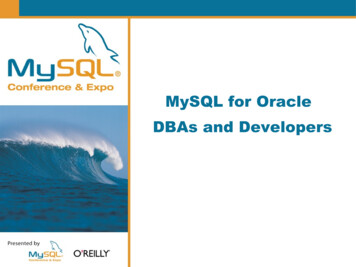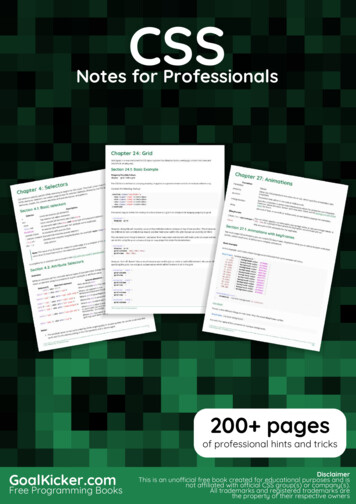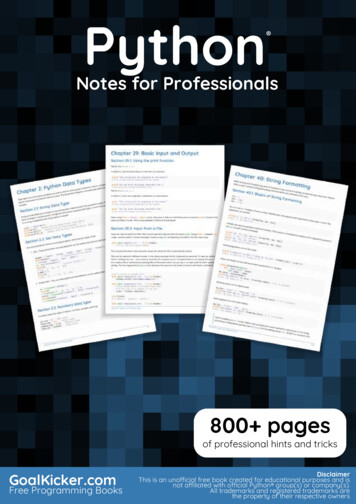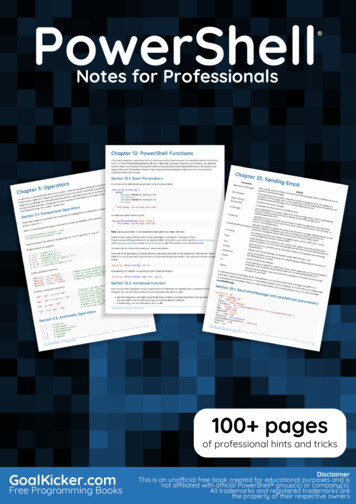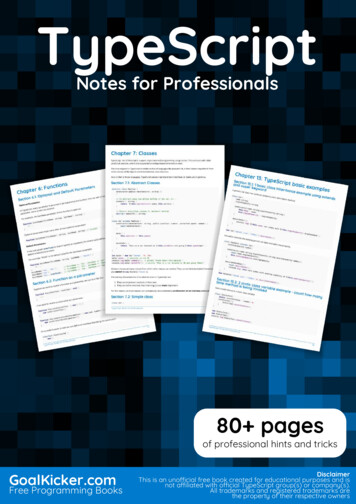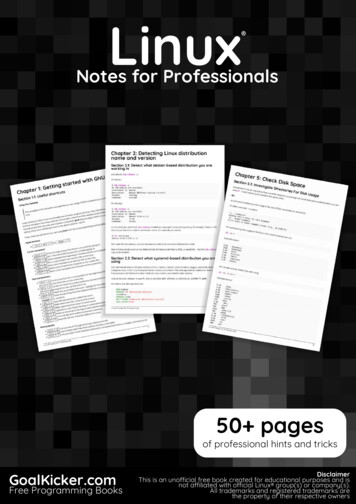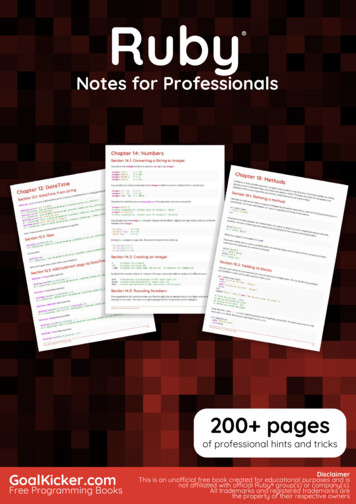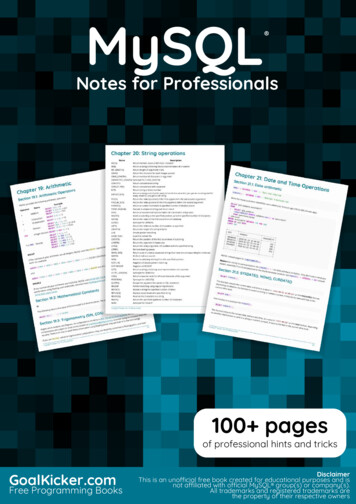
Transcription
MySQLMySQLNotes for Professionals Notes for Professionals100 pagesof professional hints and tricksGoalKicker.comFree Programming BooksDisclaimerThis is an uno cial free book created for educational purposes and isnot a liated with o cial MySQL group(s) or company(s).All trademarks and registered trademarks arethe property of their respective owners
ContentsAbout . 1Chapter 1: Getting started with MySQL . 2Section 1.1: Getting Started . 2Section 1.2: Information Schema Examples . 6Chapter 2: Data Types . 7Section 2.1: CHAR(n) . 7Section 2.2: DATE, DATETIME, TIMESTAMP, YEAR, and TIME . 7Section 2.3: VARCHAR(255) -- or not . 8Section 2.4: INT as AUTO INCREMENT . 8Section 2.5: Others . 8Section 2.6: Implicit / automatic casting . 9Section 2.7: Introduction (numeric) . 9Section 2.8: Integer Types . 10Section 2.9: Fixed Point Types . 10Section 2.10: Floating Point Types . 10Section 2.11: Bit Value Type . 11Chapter 3: SELECT . 12Section 3.1: SELECT with DISTINCT . 12Section 3.2: SELECT all columns (*) . 12Section 3.3: SELECT by column name . 13Section 3.4: SELECT with LIKE (%) . 13Section 3.5: SELECT with CASE or IF . 15Section 3.6: SELECT with Alias (AS) . 15Section 3.7: SELECT with a LIMIT clause . 16Section 3.8: SELECT with BETWEEN . 16Section 3.9: SELECT with WHERE . 18Section 3.10: SELECT with LIKE( ) . 18Section 3.11: SELECT with date range . 19Chapter 4: Backticks . 20Section 4.1: Backticks usage . 20Chapter 5: NULL . 21Section 5.1: Uses for NULL . 21Section 5.2: Testing NULLs . 21Chapter 6: Limit and O set . 22Section 6.1: Limit and O set relationship . 22Chapter 7: Creating databases . 24Section 7.1: Create database, users, and grants . 24Section 7.2: Creating and Selecting a Database . 26Section 7.3: MyDatabase . 26Section 7.4: System Databases . 27Chapter 8: Using Variables . 28Section 8.1: Setting Variables . 28Section 8.2: Row Number and Group By using variables in Select Statement . 29Chapter 9: Comment MySQL . 31Section 9.1: Adding comments . 31Section 9.2: Commenting table definitions . 31
Chapter 10: INSERT . 32Section 10.1: INSERT, ON DUPLICATE KEY UPDATE . 32Section 10.2: Inserting multiple rows . 32Section 10.3: Basic Insert . 33Section 10.4: INSERT with AUTO INCREMENT LAST INSERT ID() . 33Section 10.5: INSERT SELECT (Inserting data from another Table) . 35Section 10.6: Lost AUTO INCREMENT ids . 35Chapter 11: DELETE . 37Section 11.1: Multi-Table Deletes . 37Section 11.2: DELETE vs TRUNCATE . 39Section 11.3: Multi-table DELETE . 39Section 11.4: Basic delete . 39Section 11.5: Delete with Where clause . 39Section 11.6: Delete all rows from a table . 39Section 11.7: LIMITing deletes . 40Chapter 12: UPDATE . 41Section 12.1: Update with Join Pattern . 41Section 12.2: Basic Update . 41Section 12.3: Bulk UPDATE . 42Section 12.4: UPDATE with ORDER BY and LIMIT . 42Section 12.5: Multiple Table UPDATE . 42Chapter 13: ORDER BY . 44Section 13.1: Contexts . 44Section 13.2: Basic . 44Section 13.3: ASCending / DESCending . 44Section 13.4: Some tricks . 44Chapter 14: Group By . 46Section 14.1: GROUP BY using HAVING . 46Section 14.2: Group By using Group Concat . 46Section 14.3: Group By Using MIN function . 46Section 14.4: GROUP BY with AGGREGATE functions . 47Chapter 15: Error 1055: ONLY FULL GROUP BY: something is not in GROUP BY clause. . 50Section 15.1: Misusing GROUP BY to return unpredictable results: Murphy's Law . 50Section 15.2: Misusing GROUP BY with SELECT *, and how to fix it . 50Section 15.3: ANY VALUE() . 51Section 15.4: Using and misusing GROUP BY . 51Chapter 16: Joins . 53Section 16.1: Joins visualized . 53Section 16.2: JOIN with subquery ("Derived" table) . 53Section 16.3: Full Outer Join . 54Section 16.4: Retrieve customers with orders -- variations on a theme . 55Section 16.5: Joining Examples . 56Chapter 17: JOINS: Join 3 table with the same name of id. . 57Section 17.1: Join 3 tables on a column with the same name . 57Chapter 18: UNION . 58Section 18.1: Combining SELECT statements with UNION . 58Section 18.2: Combining data with di erent columns . 58Section 18.3: ORDER BY . 58
Section 18.4: Pagination via OFFSET . 58Section 18.5: Combining and merging data on di erent MySQL tables with the same columns into uniquerows and running query . 59Section 18.6: UNION ALL and UNION . 59Chapter 19: Arithmetic . 60Section 19.1: Arithmetic Operators . 60Section 19.2: Mathematical Constants . 60Section 19.3: Trigonometry (SIN, COS) . 60Section 19.4: Rounding (ROUND, FLOOR, CEIL) . 62Section 19.5: Raise a number to a power (POW) . 62Section 19.6: Square Root (SQRT) . 63Section 19.7: Random Numbers (RAND) . 63Section 19.8: Absolute Value and Sign (ABS, SIGN) . 63Chapter 20: String operations . 65Section 20.1: LENGTH() . 66Section 20.2: CHAR LENGTH() . 66Section 20.3: HEX(str) . 66Section 20.4: SUBSTRING() . 66Section 20.5: UPPER() / UCASE() . 67Section 20.6: STR TO DATE - Convert string to date . 67Section 20.7: LOWER() / LCASE() . 67Section 20.8: REPLACE() . 67Section 20.9: Find element in comma separated list . 67Chapter 21: Date and Time Operations . 69Section 21.1: Date arithmetic . 69Section 21.2: SYSDATE(), NOW(), CURDATE() . 69Section 21.3: Testing against a date range . 70Section 21.4: Extract Date from Given Date or DateTime Expression . 70Section 21.5: Using an index for a date and time lookup . 70Section 21.6: Now() . 71Chapter 22: Handling Time Zones . 72Section 22.1: Retrieve the current date and time in a particular time zone . 72Section 22.2: Convert a stored DATE or DATETIME value to another time zone . 72Section 22.3: Retrieve stored TIMESTAMP values in a particular time zone . 72Section 22.4: What is my server's local time zone setting? . 72Section 22.5: What time zone values are available in my server? . 73Chapter 23: Regular Expressions . 74Section 23.1: REGEXP / RLIKE . 74Chapter 24: VIEW . 76Section 24.1: Create a View . 76Section 24.2: A view from two tables . 77Section 24.3: DROPPING A VIEW . 77Section 24.4: Updating a table via a VIEW . 77Chapter 25: Table Creation . 78Section 25.1: Table creation with Primary Key . 78Section 25.2: Basic table creation . 79Section 25.3: Table creation with Foreign Key . 79Section 25.4: Show Table Structure . 80Section 25.5: Cloning an existing table . 81
Section 25.6: Table Create With TimeStamp Column To Show Last Update . 81Section 25.7: CREATE TABLE FROM SELECT . 81Chapter 26: ALTER TABLE . 83Section 26.1: Changing storage engine; rebuild table; change file per table . 83Section 26.2: ALTER COLUMN OF TABLE . 83Section 26.3: Change auto-increment value . 83Section 26.4: Renaming a MySQL table . 83Section 26.5: ALTER table add INDEX . 84Section 26.6: Changing the type of a primary key column . 84Section 26.7: Change column definition . 84Section 26.8: Renaming a MySQL database . 84Section 26.9: Swapping the names of two MySQL databases . 85Section 26.10: Renaming a column in a MySQL table . 85Chapter 27: Drop Table . 87Section 27.1: Drop Table . 87Section 27.2: Drop tables from database . 87Chapter 28: MySQL LOCK TABLE . 88Section 28.1: Row Level Locking . 88Section 28.2: Mysql Locks . 89Chapter 29: Error codes . 91Section 29.1: Error code 1064: Syntax error . 91Section 29.2: Error code 1175: Safe Update . 91Section 29.3: Error code 1215: Cannot add foreign key constraint . 91Section 29.4: 1067, 1292, 1366, 1411 - Bad Value for number, date, default, etc . 93Section 29.5: 1045 Access denied . 93Section 29.6: 1236 "impossible position" in Replication . 93Section 29.7: 2002, 2003 Cannot connect . 94Section 29.8: 126, 127, 134, 144, 145 . 94Section 29.9: 139 . 94Section 29.10: 1366 . 94Section 29.11: 126, 1054, 1146, 1062, 24 . 95Chapter 30: Stored routines (procedures and functions) . 97Section 30.1: Stored procedure with IN, OUT, INOUT parameters . 97Section 30.2: Create a Function . 98Section 30.3: Cursors . 99Section 30.4: Multiple ResultSets . 100Section 30.5: Create a function . 100Chapter 31: Indexes and Keys . 102Section 31.1: Create index . 102Section 31.2: Create unique index . 102Section 31.3: AUTO INCREMENT key . 102Section 31.4: Create composite index . 102Section 31.5: Drop index . 103Chapter 32: Full-Text search . 104Section 32.
MySQL MySQL Notes for Professionals Notes for Professionals GoalKicker.com Free Programming Books Disclaimer This is an uno cial free book created for educational purposes and is not a liated with o cial MySQL group(s) or company(s). All trademarks and registered trademar

